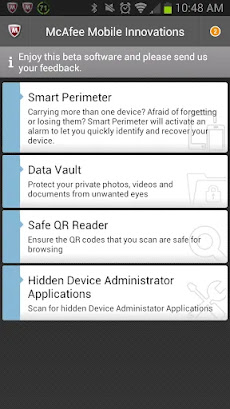From McAfee blog:
One of my friends recently locked himself out of his apartment. I found this out when I called him because although he didn't have his keys, he did have his smartphone. This was one of those times he wished he lived in one of those hotels with the Assa Abloy NFC-enabled locks.
It turns out he doesn't need to go to a hotel to open his door with a phone. Kwikset will soon be selling Kevo, a new deadbolt that can be unlocked with a Bluetooth-enabled phone. You can replace your old door locks with one of these new models.
The Kwikset/Unikey Kevo deadbolt is controlled via a Bluetooth-enabled smartphone app.
The Kevo lock [see demo video] is based on technology from Unikey, a winning company on the ABC TV show Shark Tank. Unikey’s background is in developing biometrics-access controls. Those controls are the ones you see on TV or in movies when a character places a palm or finger on a pad to open a door. With these locks we can all have similar technology guarding our homes.
Security Concerns
Another thing that you would notice from those same shows and movies is that the bad guys are always trying to break these high-security locks and access controls. The difficulty facing the average computer crook when facing a government high-tech lock is that there are so few of these locks to test against. Contrast those to millions of Bluetooth locks that one can buy off the shelf. The bar is much lower with Bluetooth because if they damage one lock during testing, the criminals can easily buy another one and try again.
The biggest payoff for technical attackers against a lock like this is to duplicate your keys or introduce a new one of their own. With physical keys they would need to get possession of them to make copies; with digital keys they need to break encryption and/or bypass security on the device that holds the keys (smartphone or key fob).
The deadbolts come with a single key fob, similar to car keys with transponders in them, and more can be purchased. It’s not clear yet whether, as with transponder keys, one needs to go through a complex process to activate additional fobs. The security of the fobs makes the smartphone a relatively easier target to go after.
There is an iPhone app that lets you manage both your own door key plus those of other residents (e.g., friends, house sitters, etc.) and temporary keys. Android phones also support Bluetooth. So the choice to produce the iPhone app first may have to do with the relative ease of decompiling Android apps.
iPhones are not necessarily more secure, as a knowledgeable attacker can jailbreak a phone and gain access to a decrypted version of the Kevo key app. Using tools like disassemblers, they can then seek out the methods used to secure the keys within the app and potentially reverse-engineer the protection or discover a method of creating new keys. They may also be able to force the app to accept new keys, essentially adding a master key to every one of these Bluetooth-enabled locks. That is actually not as likely as the criminal’s finding a way to attack a single target’s locks.
Future of Physical Security?
Locks are not invincible, not even high-tech locks. The more such locks are installed, the greater the incentive for robbers to break in through technical means. Why steal one set of keys if they can attack a smartphone app and steal all the keys? Fortunately, as the crooks start to take notice of such devices, so will security researchers. Unlike the bad guys, security folks will test these locks and help them improve. I’m sure my smartphone-toting, key-forgetting friend will appreciate that.




